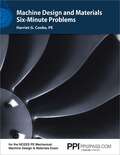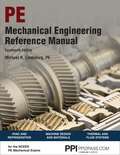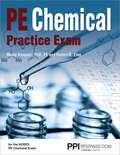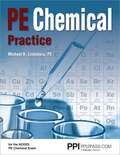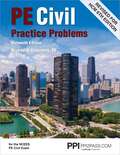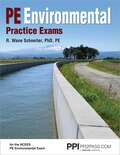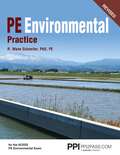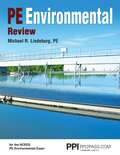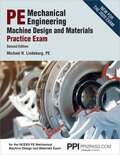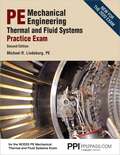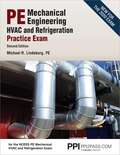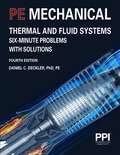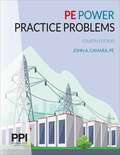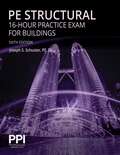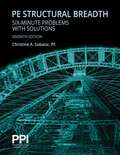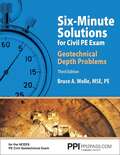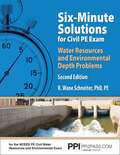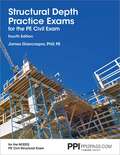- Table View
- List View
PPI Machine Design and Materials Six-Minute Problems eText - 1 Year
by Harriet G. Cooke PEComprehensive Practice for the NCEES PE Mechanical Machine Design & Materials Exam With an average of only six minutes to solve each problem on the PE Mechanical Machine Design and Materials exam, speed and accuracy are vital to your success. Machine Design and Materials Six-Minute Problems prepares you to answer even the most difficult morning and afternoon mechanical systems and materials problems in just minutes. Get your PE Mechanical Machine Design Study Schedule and PE Mechanical Reference Manual index at ppi2pass.com/downloads.Topics CoveredApplications: Joints and FastenersApplications: Materials and ProcessApplications: Mechanical ComponentsApplications: Vibration/Dynamic AnalysisPrinciples of Machine Design and MaterialsKey Features85 challenging multiple-choice problems, similar in format and difficulty to the actual exam.Two levels of difficulty: 19 morning (breadth) problems and 66 afternoon (depth) problems.A hint for each problem, to help you get started on the right path.Step-by-step solutions outlining how to strategically answer problems quickly and correctly.Explanations of the three &“distractor&” answer choices, so you can see where common errors occur and learn how to avoid them.Binding: PaperbackPublisher: PPI, A Kaplan Company
PPI Mechanical Engineering Reference Manual, 14th Edition eText - 6 Months, 1 Year
by Michael R. Lindeburg PEComprehensive Reference Manual for the NCEES PE Mechanical Exams The Mechanical Engineering Reference Manual is the most comprehensive textbook for the three NCEES PE Mechanical exams: HVAC and Refrigeration, Machine Design and Materials, Thermal and Fluid Systems. This book&’s time-tested organization and clear explanations start with the basics to help you quickly get up to speed on common mechanical engineering concepts. Together, the 75 chapters provide an in-depth review of the PE Mechanical exam topics and the NCEES Handbook. Michael R. Lindeburg&’s Mechanical Engineering Reference Manual has undergone an intensive transformation in this 14th edition to ensure focused study for success on the 2020 NCEES computer-based tests (CBT). As of April 2020, exams are offered year-round at approved Pearson Vue testing centers. The only resource examinees can use during the test is the NCEES PE Mechanical Reference Handbook. To succeed on exam day, you need to know how to solve problems using that resource. The Mechanical Engineering Reference Manual, 14th Edition makes that connection for you by using only NCEES equations in the review and problem solving.Topics CoveredFluidsThermodynamicsPower CyclesHeat TransferHVACStaticsMaterialsMachine DesignDynamics and VibrationsControl SystemsPlant EngineeringEconomicsLaw and EthicsKey FeaturesImproved design to focus study on most important PE exam materialExplanations and demonstration of how to use NCEES handbook equationsNCEES handbook equations are highlighted in blue for quick accessIn chapter callouts map to the specific PE exam to streamline review processExtensive index contains thousands of entries, with multiple entries included for each topicBinding: HardcoverPublisher: PPI, A Kaplan Company
PPI PE Chemical Practice Exam eText - 1 Year
by Marta Vasquez PhD, PE Robert R. ZinnGet your PR Chemical Review index at ppi2pass.com/downloads.PE Chemical Practice Exam (PECHPE) offers comprehensive practice for the NCEES Chemical PE exam. This book is part of a comprehensive learning management system designed to help you pass the NCEES Chemical PE exam the first time.PE Chemical Practice Exam (PECHPE) features include: Consistent with the NCEES Chemical PE CBT exam&’s format, scope of topics, number of problems, and level of difficultyContains one full practice exam 80 multiple-choice problemsProblems are solvable in an average of six minutesThis book is a companion to the PE Chemical Review (PECHRM) in chapter sequence, nomenclature, terminology, and methodology, so you can easily find clear explanations of topics where you need more support.Exam Topics Covered Energy BalancesFluidsHeat TransferKineticsMass BalancesMass TransferPlant Design and OperationThermodynamics
PPI PE Chemical Practice eText - 1 Year: A Companion To The Chemical Engineering Reference Manual
by Michael R. Lindeburg PEComprehensive Practice for the NCEES PE Chemical ExamPE Chemical Practice Problems offers comprehensive practice for the NCEES Chemical PE CBT exam. Problems are similar in length and format, with references to the NCEES PE Chemical Reference Handbook to ensure the problems cover similar concepts as what will be encountered on the exam. This book is part of a complete learning management system designed to fully prepare you for the PE exam. Get your PE Chemical Review index at ppi2pass.com/downloads.Topics CoveredFluids Fluid PropertiesFluid StaticsFluid Flow ParametersFluid DynamicsHydraulic MachinesThermodynamics Inorganic ChemistryFuels and CombustionProperties of SubstancesVapor, Combustion, and Nuclear Power Cycles Refrigeration and Gas Compression CyclesHeat Transfer ConductionNatural ConvectionForced ConvectionRadiation Environmental Water Supply and WastewaterBiology and BacteriologySludgeSolid WasteMass Transfer Basic PrinciplesVapor-Liquid ProcessesLiquid-Liquid ExtractionSolid-Liquid ProcessesChemical Plant Design Basic Chemical Plant DesignPsychrometricsVentilation and HumidificationEngineering MaterialsPhysical Properties of Construction MaterialsThermal Treatment of MetalsModeling and Analysis of Engineering SystemsProcess Monitoring and InstrumentationWorkplace SafetyProcess and Production OptimizationEngineering Economic AnalysisKey FeaturesContains exam-like practice problems for the PE Chemical CBT examStep-by-step calculations using equations and nomenclature from the NCEES PE Chemical Reference Handbook to familiarize you with the reference you&’ll have on exam dayBinding: PaperbackPublisher: PPI, A Kaplan Company
PPI PE Civil Practice Problems, 16th Edition eText - 1 Year
by Michael R. Lindeburg PEPE Civil Practice Problems contains over 900 problems designed to reinforce your knowledge of the topics presented in the PE Civil Reference Manual. Short, six-minute, multiple-choice problems follow the NCEES PE Civil exam problem format and focus on individual engineering concepts. Longer, more complex problems challenge your skills in identifying and applying related engineering concepts. Problems will also familiarize you with the codes and standards you&’ll use on the exam. Solutions are clearly written, complete, and easy to follow. U.S. customary and SI units are equally supported, and units are meticulously identified and carried through in all calculations. All solution methodologies permitted by the NCEES PE Civil exam (e.g., ASD and LRFD) are presented. Frequent references to figures, tables, equations, and appendices in the PE Civil Reference Manual and the exam-adopted codes and standards will direct you to relevant support material.Topics Covered:Civil Breadth Project Planning; Means and Methods; Soil Mechanics; Structural Mechanics; Hydraulics and Hydrology; Geometrics; Materials; Site DevelopmentConstruction Earthwork Construction and Layout; Estimating Quantities and Costs; Construction Operations and Methods; Scheduling; Material Quality Control and Production; Temporary Structures; Health and SafetyGeotechnical Site Characterization; Soil Mechanics, Laboratory Testing, and Analysis; Field Materials Testing, Methods, and Safety; Earthquake Engineering and Dynamic Loads; Earth Structures; Groundwater and Seepage; Problematic Soil and Rock Conditions; Earth Retaining Structures; Shallow Foundations; Deep FoundationsStructural Analysis of Structures; Design and Details of Structures; Codes and ConstructionTransportation Traffic Engineering; Horizontal Design; Vertical Design; Intersection Geometry; Roadside and Cross-Section Design; Signal Design; Traffic Control Design; Geotechnical and Pavement; Drainage; Alternatives AnalysisWater Resources and Environmental Analysis and Design; Hydraulics–Closed Conduit; Hydraulics–Open Channel; Hydrology; Groundwater and Wells; Wastewater Collection and Treatment; Water Quality; Drinking Water Distribution and Treatment; Engineering Economic Analysis Key Features: Over 900 practice problems to help prepare you for the NCEES PE Civil Exam.Frequent references to figures, tables, equations, and appendices in the PE Civil Reference Manual.Binding: PaperbackPublisher: PPI, A Kaplan Company
PPI PE Civil Structural Depth Six-Minute Problems eText - 1 Year
by Christine A. Subasic PEProblems and Detailed Solutions for Comprehensive Exam Prep Up to date to the NCEES exam specifications and codes, PE Civil Structural Depth Six-Minute Problems contains over 100 multiple-choice problems representative of the PE Civil Structural exam format, scope of topics, and level of difficulty. Comprehensive step-by-step solutions for all problems demonstrate accurate and efficient solving approaches to be used on exam day. Pair these problems with the Structural Depth Reference Manualand Practice Exams for a comprehensive review. This book is included in the PE Civil Structural Complete Exam Bundle.Updated Reference Codes and StandardsAmerican Wood Council Special Design Provisions for Wind and SeismicAASHTO LRFD Bridge Design SpecificationsBuilding Code Requirements and Specification for Masonry Structures (ACI 530/530.1)Building Code Requirements for Structural Concrete (ACI 318)Minimum Design Loads for Buildings and Other Structures (ASCE/SEI7)International Building Code (IBC)National Design Specification for Wood Construction ASD/LRFD (NDS)PCI Design Handbook: Precast and Prestressed Concrete (PCI)Safety and Health Regulations for Construction (OSHA 29 CFR Part 1926)Steel Construction Manual (AISC)About the exam The NCEES PE Civil Structural Exam is an 8-hour open-book exam. The exam is a breadth and depth examination. You will work the breadth exam in the morning (4-hours, 40 multiple-choice questions) and the Structural depth exam in the afternoon (4-hours, 40 multiple-choice questions).Key FeaturesOver 100 multiple-choice problems.Follows exam format, scope of topics, and level of difficulty.Assess and strengthen your problem-solving skills.Binding: PaperbackPublisher: PPI, A Kaplan Company
PPI PE Environmental Practice Exams eText - 1 Year
by R. Wane Schneiter PhD, PEMock Practice Exams for the PE Environmental ExamThe best way to prepare for the PE Environmental exam is by taking PE Environmental Practice Exams. These practice exams closely mirror the complete exam experience by covering the six primary topics on the exam and matching the level of difficulty, length, and question format.Two full-length practice exams, each with 80 multiple-choice problems (40 morning problems and 40 afternoon problems) cover the full range of exam topics. Fully explained solutions for each problem supplement your study regime and assess your readiness for the exam. The book also includes valuable exam tips, approaches, and insights to increase your confidence and improve your chances of passing. Topics CoveredAirAssociated Engineering PrinciplesEnvironmental Health and SafetySite Assessment and RemediationSolid and Hazardous WasteWaterKey FeaturesConsistent with the exam scope and formatAssess problem-solving skills and reveal topics that require extra reviewDemonstrates the most efficient way to solve problemsIdentifies references used most often during the examSolve problems under exam-like timed conditionsBinding: PaperbackPublisher: PPI, A Kaplan Company The PE Environmental Practice Exams and its companion products are part of PPI&’s best-selling exam-review series, used by more than 4 million engineers to prepare for their licensing exams.
PPI PE Environmental Practice Problems eText - 1 Year
by R. Wane Schneiter PhD, PEComprehensive Practice for the PE Environmental Exam A revised version of PE Environmental Practice Problems (PEENPP) has been released. The original version was inadvertently sent to the printer before the final proofing process. We apologize for any inconvenience this may have caused. The new corrected edition has a "Revised" banner on the top right corner of the front cover. If you still have the original version of the book, please contact us at ppi2pass.com. The PE Environmental Practice (PEENPP) offers the most comprehensive practice for the NCEES Environmental PE CBT exam. Practice builds exam confidence and strengthens time management skills. The book&’s content is up to date to the latest exam specifications and codes, coordinates with the PE Environmental Review (PEENRM) and includes uniform chapter sequences, nomenclature, terminology, and methodology. After you&’ve practiced, take the PE Environmental Practice Exams (PEENPX) to simulate a realistic NCEES exam experience.Key features500+ exam-like problems in both multiple-choice and essay formats, along with detailed explanations covering exam-specific topics.Six-minute multiple-choice problems focus on individual concepts, while longer complex problems challenge you to identify and apply engineering concepts.Problems are similar in length and format, and with references to the NCEES PE Environmental Reference Handbook to ensure the problems cover similar concepts as what will be encountered on the exam.Step-by-step calculations using equations and nomenclature from the NCEES to familiarize you with the reference you&’ll have on exam day.Binding: PaperbackPublisher: PPI, A Kaplan Company
PPI PE Environmental Review eText - 1 Year
by Michael R. Lindeburg PEYou need this book for your CBT preparation! The PE Environmental CBT exam is NOT open book. You will only be allowed to use the NCEES supplied electronic reference on the exam. Ensure exam day success with the new PE Environmental Review from Michael R. Lindeburg, PE.PE Environmental Review offers the complete review for the new NCEES Environmental PE CBT exam. This book is the most up-to-date, comprehensive reference manual available, and is designed to the exact order of the exam.Topics CoveredWater: Principles, Wastewater, Stormwater, Potable Water, Water ResourcesAir: Principles, Pollution ControlSolid and Hazardous Waste: Principles, Municipal and Industrial Solid Waste, Hazardous, Medical, and Radioactive WasteSite Assessment and RemediationEnvironmental Health and SafetyAssociated Engineering PrinciplesAbout the Exam The NCEES PE Environmental CBT Exam is a 9-hour computer-based exam. It is closed book with an electronic reference. Examinees have 9 hours to complete the 80 question exam. The 9-hour time includes a tutorial and optional break. This exam uses both the International System of units (SI) and the US Customary System (USCS).Key Features: Easy to find content organized in same order as the examUse of NCEES Handbook equations, tables, and figuresTeaching of how to solve exam problems with specific NCEES Handbook equationsIndustry-standard terminology and nomenclatureEqual support of U.S. customary and SI unitsBinding: PaperbackPublisher: PPI, A Kaplan CompanyAfter you Pass Your PE Environmental Review will serve as an invaluable reference throughout your environmental engineering career.
PPI PE Mechanical Engineering Machine Design and Materials Practice Exam, 2nd Edition eText - 1 Year
by Michael R. Lindeburg PEMechanical Engineering Machine Design and Materials Practice Exam, Second Edition New Edition - Updated for the CBT Exam Build exam-day confidence and strengthen time-management skills Up-to-date to the NCEES exam specifications for the Computer-Based (CBT) PE Mechanical Engineering Machine Design and Materials exam, this book offers comprehensive practice to ensure success on exam day. This mechanical engineering book is part of a comprehensive learning management system designed to help you pass the PE exam the first time. About the exam The NCEES PE Mechanical CBT Exam is an 8-hour computer-based exam. It is closed book with an electronic reference. Examinees have a 9-hour appointment time. The 9-hour time includes a tutorial and optional break.Key FeaturesComplete 80 question PE practice exam for the CBT examCoverage of all exam knowledge areasUse of NCEES Handbook equationsComprehensive step-by-step solutionsBinding: PaperbackPublisher: PPI, A Kaplan Company
PPI PE Mechanical Engineering Thermal and Fluids Systems Practice Exam, 2nd Edition eText - 1 Year
by Michael R. Lindeburg PEMechanical Engineering Thermal and Fluids Systems Practice Exam, Second Edition New Edition - Updated for the CBT Exam Build exam-day confidence and strengthen time-management skills Up-to-date to the NCEES exam specifications for the Computer-Based (CBT) PE Mechanical Engineering Thermal and Fluids Systems exam, this book offers comprehensive practice to ensure success on exam day. This mechanical engineering book is part of a comprehensive learning management system designed to help you pass the PE exam the first time.About the exam The NCEES PE Mechanical CBT Exam is an 8-hour computer-based exam. It is closed book with an electronic reference. Examinees have a 9-hour appointment time. The 9-hour time includes a tutorial and optional break. Key Features:Complete 80 question PE practice exam for the CBT examCoverage of all exam knowledge areasUse of NCEES Handbook equationsComprehensive step-by-step solutionsBinding: PaperbackPublisher: PPI, A Kaplan Company
PPI PE Mechanical HVAC and Refrigeration Practice Exam, 2nd Edition eText - 1 Year
by Michael R. Lindeburg PERealistic Practice for the PE Mechanical HVAC and Refrigeration ExamPE Mechanical Engineering HVAC and Refrigeration Practice Exam offers complete practice for the NCEES PE Mechanical HVAC and Refrigeration exam. Up to date to the NCEES exam specifications for the Computer-Based (CBT) PE Mechanical HVAC and Refrigeration exam, the new edition of this book helps build exam-day confidence and strengthen time management skills. Part of a comprehensive learning management system, PE Mechanical Engineering HVAC and Refrigeration Practice Exam is a companion to the Mechanical Engineering Reference Manual in chapter sequence, nomenclature, terminology, and methodology, so you can easily find clear explanations of topics where you need more support.About the Exam The NCEES PE Mechanical CBT Exam is an 8-hour computer-based exam. It is closed book with an electronic reference. Examinees have a 9-hour appointment time. The 9-hour time includes a tutorial and optional break.Key FeaturesComplete 80 question practice exam for the CBT examCoverage of all exam knowledge areasUse of NCEES Handbook equationsComprehensive step-by-step solutionsBinding: PaperbackPublisher: PPI, A Kaplan Company
PPI PE Mechanical Thermal and Fluid Systems Six-Minute Problems with Solutions, 4th Edition eText - 1 Year
by Daniel C. Deckler PhD, PEPE Mechanical Thermal and Fluid Systems Six-Minute Problems with Solutions, Fourth Edition, prepares you to solve even the most difficult PE exam problems. With 100 multiple-choice problems covering all knowledge areas of the PE Mechanical: Thermal and Fluid Systems exam, you will learn important strategies for solving problems quickly and efficiently. The solutions in this edition include references to NCEES Handbook sections to better prepare you for the computer-based format of the exam.Key Features:Coverage of all exam knowledge areas in the NCEES specificationsOrganization of problems into three sections that align with the exam: Principles, Hydraulic and Fluid Applications, and Energy/Power System ApplicationsProblems in the same CBT format as encountered on the PE exam Hints for every problem to help you get startedStep-by-step solutions detailing how to approach solving each problemReferences to NCEES Handbook sections to help you become familiar with the location of important equations, figures, and tables in the HandbookExplanations of the faulty reasoning leading to the incorrect answer options
PPI PE Power Practice Exams, 4th Edition eText - 1 Year
by John A. Camara PEBuild exam-day confidence and strengthen time-management skills John A. Camara's PE Power Practice Exams, Fourth Edition, offers the most realistic practice exam on the market for the NCEES Electrical and Computer - Power Exam. Up-to-date to the NCEES exam specifications for the Computer-Based (CBT) PE Electrical Power exam, this book offers comprehensive practice to ensure success on exam day. The content is always up-to-date to the latest exam specifications and codes. Codes used to prepare this book include: NEC 2017, NESC 2017, NFPA 70E and others. The time-tested, detailed instructional design of the practice exams provides you with the most efficient and effective practice. New Features Include:Two complete 80 question practice exams for the CBT examCoverage of all exam knowledge areasUse of NCEES Handbook equationsComprehensive step-by-step solutions
PPI PE Power Practice Problems, 4th Edition eText - 1 Year
by John A. Camara PEComprehensive Practice for the NCEES PE Electrical Power ExamsPE Power Practice Problems, Fourth Edition by John A. Camara, PE has undergone an intensive transformation to ensure focused practice on the new NCEES PE Electrical Power computer-based test (CBT). The only resource examinees can use during the test will be the NCEES PE Power Reference Handbook and the specified codes. To succeed on exam day, you need to know how to solve problems using that resource. PE Power Practice Problems makes that connection for you by using NCEES equations in the problems and solutions. New features Include:Curated high priority exam-like questionsStep-by-step solutions demonstrate how to solve using NCEES handbook equationsAll NCEES equations are highlighted in blue for quick accessAll problems can be solved using NCEES HandbookProblem and chapters align with PE Power Reference Manual so you can review and practice easilyTopics Covered:Circuits: Analysis; Devices and Power Electronic CircuitsGeneral Power Engineering: Measurement and Instrumentation; Applications; Codes and StandardsRotating Machines and Electric Power Devices: Induction and Synchronous Machines; Electric Power DevicesTransmission and Distribution: Power System Analysis; Protection
PPI PE Structural 16-Hour Practice Exam for Buildings, 6th Edition - 1 Year
by Joseph S SchusterPE Structural 16-Hour Practice Exam for Buildings, Sixth Edition offers comprehensive practice for the NCEES PE Structural (SE) exam. This book is part of a comprehensive learning management system designed to help you pass the PE Structural exam the first time.PE Structural 16-Hour Practice Exam for Buildings, Sixth Edition features include: The Most Realistic Practice for the PE Structural ExamTwo 40-problem, multiple-choice breadth examsTwo four-essay depth exams consistent with the NCEES PE Structural exam&’s format and specificationsMultiple-choice problems require an average of six minutes to solveEssay problems can be solved in one hourComprehensive step-by-step solutions for all problems demonstrate accurate and efficient problem-solving approachesSolutions to the depth exams&’ essay problems use blue text to identify the information you will be expected to include in your exam booklet to receive full creditSupplemental content uses black text to enhance your understanding of the solution process Referenced Codes and Standards AASHTO LRFD Bridge Design Specifications (AASHTO) 8th Ed. Building Code Requirements and Specification for Masonry Structures (TMS 402/602) 2016 Ed. Building Code Requirements for Structural Concrete (ACI 318) 2014 Ed.International Building Code (IBC) 2018 Ed. Minimum Design Loads for Buildings and Other Structures (ASCE/SEI7) 2016 Ed.National Design Specification for Wood Construction ASD/LRFD and National Design Specification Supplement, Design Values for Wood Construction (NDS) 2018 Ed. Seismic Design Manual (AISC 327) 3rd Ed. Special Design Provisions for Wind and Seismic with Commentary (SDPWS) 2015 Ed. Steel Construction Manual (AISC 325) 15th Ed. eTextbook Access Benefits Include: One year of accessAbility to download the entire eTextbook to multiple devices, so you can study even without internet accessAn auto sync feature across all your devices for a seamless experience on or offlineUnique study tools such as highlighting in six different colors to tailor your study experienceFeatures like read aloud for complete hands-free review
PPI PE Structural Breadth Six-Minute Problems with Solutions, 7th Edition - 1 Year
by Christine A. Subasic PEPE Structural Breadth Six-Minute Problems with Solutions, Seventh Edition offers comprehensive practice for the NCEES PE Structural (SE) exam. This book is part of a comprehensive learning management system designed to help you pass the PE Structural exam the first time.PE Structural Breadth Six-Minute Problems with Solutions, Seventh Edition features include: 90 multiple-choice problems are grouped into two chapters—vertical forces and lateral forces—that correspond to the exam&’s two breadth exam componentsProblems are representative of the breadth exam&’s format, the scope of topics, and level of difficultyEach problem includes a hint that provides optional problem-solving guidanceA comprehensive step-by-step solution for each problem demonstrates accurate and efficient solving approaches Referenced Codes and Standards AASHTO LRFD Bridge Design Specifications (AASHTO) 8th Ed. Building Code Requirements and Specification for Masonry Structures (TMS 402/602) 2016 Ed. Building Code Requirements for Structural Concrete (ACI 318) 2014 Ed.International Building Code (IBC) 2018 Ed. Minimum Design Loads for Buildings and Other Structures (ASCE/SEI7) 2016 Ed.National Design Specification for Wood Construction ASD/LRFD and National Design Specification Supplement, Design Values for Wood Construction (NDS) 2018 Ed. Seismic Design Manual (AISC 327) 3rd Ed. Special Design Provisions for Wind and Seismic with Commentary (SDPWS) 2015 Ed. Steel Construction Manual (AISC 325) 15th Ed. eTextbook access benefits include: One year of accessAbility to download the entire eTextbook to multiple devices, so you can study even without internet accessAn auto sync feature across all your devices for a seamless experience on or offlineUnique study tools such as highlighting in six different colors to tailor your study experienceFeatures like read aloud for complete hands-free review
PPI PE Structural Bridges Practice Problems with Solutions – Practice Problems with Full Solutions for the NCEES PE Structural Engineering (SE) Exam
by David Micnhimer PE, SEDavid Micnhimer&’s PE Structural Bridges Practice Problems with Solutions (STBR) is a new book designed to help practice for Bridge questions on the PE Structural (SE) Exam. This book is a comprehensive review of different types of bridge questions you can encounter on the breadth portion of the exam. Features of this book:77 multiple-choice questions to test your knowledge of bridge designUp-to-date with codes and references for the October 2021 PE Structural (SE) ExamComplete solutions show you step-by-step how to solve problems
PPI Six-Minute Solutions for Civil PE Exam Geotechnical Depth Problems, 3rd Edition eText - 1 Year
by Bruce A. Wolle MSE, PETargeted Training for Solving Civil PE Exam Geotechnical Depth Multiple-Choice ProblemsSix-Minute Solutions for Civil PE Exam Geotechnical Depth Problems contains 102 multiple-choice problems that are grouped into ten chapters. Each chapter corresponds to a topic on the NCEES PE Civil exam geotechnical depth section. Like the PE exam, an average of six minutes is required to solve each problem in this book. Each problem also includes a hint that provides optional problem-solving guidance.Topics CoveredDeep FoundationsEarth Retaining StructuresEarth StructuresEarthquake Engineering and Dynamic LoadsField Materials Testing, Methods, and SafetyGroundwater and SeepageProblematic Soil and Rock ConditionsShallow FoundationsSite CharacterizationSoil Mechanics, Lab Testing, and AnalysisReferenced Design StandardsMinimum Design Loads for Buildings and Other Structures (ASCE 7)Safety and Health Regulations for Construction (OSHA 29 CFR Part 1926)Key FeaturesProblems are representative of the exam&’s format, scope of topics, and level of difficulty.Connect relevant theory to exam-like problems.Comprehensive step-by-step solutions for all problems demonstrate accurate and efficient solving approaches.Organize the codes and references you will use on exam day.Binding: PaperbackPublisher: PPI, A Kaplan Company
PPI Six-Minute Solutions for Civil PE Exam Water Resources and Environmental Depth Problems, 2nd Edition eText - 1 Year
by R. Wane Schneiter PhD, PETargeted Training for Solving Civil PE Water Resources and Environmental Depth Exam ProblemsSix-Minute Solutions for Civil PE Exam Water Resources and Environmental Depth Problems contains 100 multiple-choice problems that are grouped into nine chapters that correspond to a topic on the PE Civil water resources and environmental depth exam. Problems are representative of the exam&’s format, scope of topics, and level of difficulty. Like the PE exam, an average of six minutes is required to solve each problem in this book. Each problem includes a hint to provide direction in solving the problem. In addition to the correct solution, you will find an explanation of the faulty solutions leading to the three incorrect answer options. The incorrect options are intended to represent common mistakes specific to different problem types. The solutions are presented in a step-by-step sequence to help you follow the logical development of the correct solution and to provide examples of how you may want to approach your solutions as you take the PE exam.Topics CoveredAnalysis and DesignDrinking Water Distribution and TreatmentEngineering Economics AnalysisGroundwater and WellsHydraulics—Closed ConduitHydraulics—Open ChannelHydrologyWastewater Collection and TreatmentWater QualityKey FeaturesMost problems are quantitative, requiring calculations to arrive at a correct solution; a few are nonquantitative.Increase familiarity with the exam problems&’ format, content, and solution methods.Connect relevant theory to exam-like problems.Quickly identify accurate problem-solving approaches.Engage with references you will use on exam day.Binding: PaperbackPublisher: PPI, A Kaplan Company
PPI Six-Minute Solutions for Civil PE Exam: Construction Depth Problems eText - 1 Year
by Elaine Huang PETargeted Training for Solving Civil PE Exam Construction Depth Multiple-Choice ProblemsSix-Minute Solutions for Civil PE Exam Construction Depth Problems contains over 100 multiple-choice problems that are grouped into seven chapters that correspond to a topic on the PE Civil exam construction depth section. Problems are representative of the exam&’s format, scope of topics, and level of difficulty. Like the PE exam, an average of six minutes is required to solve each problem in this book. Each problem also includes a hint for optional problem-solving guidance. Comprehensive step-by-step solutions for all problems demonstrate accurate and efficient solving approaches. Get your Construction Depth Reference Manual index at ppi2pass.com/downloads.Topics CoveredConstruction Operations and MethodsEarthwork Construction and LayoutEstimating Quantities and CostsHealth and SafetyMaterial Quality Control and ProductionSchedulingTemporary StructuresKey FeaturesIncrease familiarity with the exam problems&’ format, content, and solution methodsConnect relevant theory to exam-like problemsQuickly identify accurate problem-solving approachesOrganize the references you will use on exam dayBinding: PaperbackPublisher: PPI, A Kaplan Company
PPI Structural Depth Practice Exams for the PE Civil Exam, 4th Edition eText - 1 Year
by James Giancaspro PhD, PETwo Realistic 40-Problem Structural Depth ExamsStructural Depth Practice Exams for the PE Civil Exam contains two 40-problem, multiple-choice exams consistent with the NCEES PE Civil structural depth exam&’s format and specifications. Like the actual exam, the problems in this book require an average of six minutes to solve. Comprehensive step-by-step solutions demonstrate accurate and efficient problem-solving approaches. Author commentary is provided in the solutions to explain time-saving shortcuts and common pitfalls.Structural Depth Practice Exams will help youEffectively familiarize yourself with the exam scope and format.Quickly identify accurate and efficient problem-solving approaches.Successfully connect relevant theory to exam-like problems.Efficiently navigate through exam-adopted codes and standards.Confidently solve problems under timed conditions. Referenced Codes and StandardsAASHTO LRFD Bridge Design Specifications (AASHTO)Building Code Requirements and Specification for Masonry Structures (ACI 530/530.1-13)Building Code Requirements for Structural Concrete (ACI 318)Minimum Design Loads for Buildings and Other Structures (ASCE/SEI7)International Building Code (IBC)National Design Specification for Wood Construction ASD/LRFD (NDS)PCI Design Handbook: Precast and Prestressed Concrete (PCI)Safety and Health Regulations for Construction (OSHA 29 CFR Part 1926)Steel Construction Manual (AISC)Key Features:Two 40-problem, multiple-choice exams consistent with the NCEES PE Civil structural depth exam.Comprehensive step-by-step solutions demonstrate accurate and efficient problem-solving approaches.Comprehensive solutions, including commentary by the author, to explain time-saving shortcuts and common pitfalls.Binding: PaperbackPublisher: PPI, A Kaplan Company
PPI Surveying Solved Problems, 5th Edition eText - 1 Year
by Jan Van Sickle PLSProblems and Detailed Solutions for Comprehensive Exam PrepSurveying Solved Problems contains over 900 multiple-choice problems representing a broad range of topics on both the Fundamentals of Surveying (FS) and Principles and Practice of Surveying (PS) exams. The problem scenarios are instructionally designed so that you learn how to identify and apply related concepts and equations. The breadth of topics covered, and the varied complexities of the problems allow you to assess and strengthen your problem-solving skills, while step-by-step solutions demonstrate accurate, efficient solving methods. Pair these solved problems with the Reference Manual for a comprehensive review, and the Practice Exam to maximize your problem-solving efficiency and build exam-day readiness. Surveying Solved Problems is included in all Fundamentals of Surveying Complete Exam Bundle.About the FS exam The NCEES FS Exam is your first step in becoming a professional surveyor (P.S.). The exam is a closed book computer-based exam containing 110 questions. You will receive an electronic reference at the exam.About the PS exam The NCEES PS Exam is a closed book computer-based exam containing 100 questions. You will receive an electronic reference at the exam.Key FeaturesPractice using the appropriate NCEES-supplied reference.Consistent with exam topics.Learn accurate and efficient problem-solving approaches.Connect relevant theory to exam-like problems.Binding: PaperbackPublisher: PPI, A Kaplan Company
PPI Surveyor Reference Manual eText - 1 Year
by George M. Cole PhD, PE, PLSThe Reference Manual every Surveying examinee needs! George Cole&’s Surveyor Reference Manual, Seventh Edition (SVRM7) offers a complete review for the NCEES Fundamentals of Surveying (FS) Exam. This book is the most up-to-date, comprehensive reference manual available, and is designed to help you pass the NCEES FS exam the first time!Topics CoveredAlgebra, Basic Geometry, Trigonometry, CalculusField Data AcquisitionPlane Survey CalculationsGeodesy and Survey AstronomyCadastral and Boundary LawMappingSpecialty Surveying AreasAccuracy Standards Pair this reference manual with Solved Problems for a comprehensive review, and the Practice Exam to maximize your problem-solving efficiency and build exam-day readiness. This manual is included in all Fundamentals of Surveying Complete Exam BundleAbout the FS exam The NCEES FS Exam is your first step in becoming a professional surveyor (P.S.). The exam is a closed book computer-based exam containing 110 questions. You will receive and electronic reference at the exam.About the PS exam The NCEES PS Exam is a closed book computer-based exam containing 100 questions. You will receive and electronic reference at the exam.After you pass Surveyor Reference Manual, Seventh Edition (SVRM7) will serve as an invaluable reference throughout your surveying career. Key Features: 44 chapters provide an in-depth review of FS exam topics.Introduces many subjects covered on the Principles and Practice of Surveying (PS) exam.Enhanced coverage on aerial mapping.8 appendices containing essential support material.Over 300 practice problems to build your problem-solving skills.Over 120 common surveying terms defined in an easy-to-use glossary.Hundreds of equations, figures, and tables.Industry-standard terminology and nomenclature.Example problems that demonstrate how to apply the concepts presented.Binding: PaperbackPublisher: PPI, A Kaplan Company
PPI Thermal and Fluids Systems Reference Manual for the Mechanical PE Exam eText - 1 Year
by Jeffrey A. Hanson PEComprehensive PE Mechanical Thermal and Fluids Systems Exam Coverage The Thermal and Fluids Systems Reference Manual prepares you for the NCEES Mechanical Thermal and Fluids Systems Exam. It provides a comprehensive review of the principles of thermal and fluids systems. You will learn how to apply concepts by reviewing and working the 88 end-of-topic practice problems. Each problem&’s complete solution let you check your own problem-solving approach. After the exam, the Thermal and Fluids Systems Reference Manual is a valuable reference for your mechanical engineering career.Topics CoveredEnergy and Power EquipmentFluid MechanicsHeat Transfer PrinciplesHydraulic and Fluid EquipmentThermodynamicsKey FeaturesThorough index easily directs you to the codes and concepts you will need during the exam.Additional support materials with cross references to more than 1500 equations, 300 figures, and 30 tables.Binding: PaperbackPublisher: PPI, A Kaplan Company
